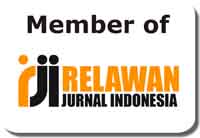Orientalist Construction on the Existence of Ammiyah Arabic in Egypt in the 20th Century
Abstract
This study aims to explorehow the Ammiyah language came about in Egypt in the 20th century. It adopted an observational research design. To gather the data, the books and journals covering Orientalism were examined.The study details three of the findings. First, the Ammiyah language differs from the Arabic Fusha in terms of syntax, lexical and phonological characteristics. Second, Ammiyah has often been used in Egypt in familial and social communication. Third, the construction carried out by Orientalists in popularizing the Ammiyah language in order to shift the role of the Arabic Fusha as the language of state administration in Egypt through two aspects. The government orders the writing of books and newspapers in the Ammiyah language using Latin letters, and prohibits the teaching of Fusha language in the school and all activities. Although the Orientalist effort failed because of the opposition from Arab literary groups both Muslim and Christian Arabs, as well as the Al-Azhar and Majma 'Lughah Universities which protected the purity of the Arabic language, there was still a social impact on Egyptian society. The Egyptian society utilizes a number of Ammiyah languages in day-to-day contact.
Keywords
Full Text:
PDFReferences
Abdullah, I. (2006). Konstruksi dan Reproduksi Kebudayaan. Pustaka Pelajar.
Abdullah, I., Jubba, H., Pabbajah, M., Sari, I. P., Zuhri, S., Ernas, S. (2019). “From Selfism to Indifferentism: Challenges Facing Indonesian Society and Culture, 2015-2045.” Academic Journal of Interdisciplinary Studies 8(3): 102–12. https://doi.org/10.36941/ajis-2019-0009.
Al-khathla, A. A. A. R. (2017). Arabic grammar between text construction concept and its analysis. (Journal of Linguistic and Literary Studies), 8(1).
Allen, J., & Hermann-Wilmarth, J. (2004). Cultural construction zones. Journal of Teacher Education, 55(3), 214–226.
Andriani, A. (2018). Frasa dalam bahasa Arab (konstruksi frasa dalam bahasa Arab berdasarkan unsur kata pembentuknya). Cendekia: Jurnal Studi Keislaman, 2(1), 103-113.
Arif, S. (2008). Orientalis & Diabolisme Pemikiran. Gema Insani.
Arkoun, M., & Lee, R. D. (2019). Rethinking Islam: Common questions, uncommon answers. Routledge.
Aziz, M. H. A. (2005). Al-Lughah al-‘Arabiyah fī al-Qarni al-Hādī wa al-‘Isyrīn. Dar al-‘Ulum.
Aziz, M. H. A. (2009). Ilmu al-Lughah al-Ijtimā‘iy. Maktabah al-Adab.
Badaw̄i, M. M. (1993). A Short History of Modern Arabic Literature. Oxford [England]: Clarendon Press; New York: Oxford University Press.
Baharudin, H., & Ismail, Z. (2014). Vocabulary learning strategies and Arabic vocabulary size among pre-university students in Malaysia. International Education Studies, 7(13), 219–226.
Berger, P. L., Parera, F. M., & Luckman, T. (1990). Tafsir sosial atas kenyataan: Risalah tentang sosiologi pengetahuan. LP3ES.
Buhori, B., & Wahidah, B. (2017). Bahasa Arab dan peradaban Islam: Telaah atas sejarah perkembangan bahasa Arab dalam lintas sejarah peradaban Islam. Jurnal Al-Hikmah: Jurnal Dakwah, 11(1).
Burdah, I. (2011). Ṭarīqat al-tarjamah al-waẓīfiyyah al-mu‘jamiyyah al-mu‘allaqah taṣawwur ‘ām wa al-baḥṡ al-tārīkhī ‘anhā. Journal of Indonesian Islam, 5(2), 353–377.
Comrie, B. (2009). The world’s major languages. Routledge.
Errington, J. (2001). Colonial linguistics. Annual Review of Anthropology, 30(1), 19–39.
Fiske, W. (1904). An Egyptian Alphabet for the Egyptian People.... Landi Press.
Gairdner, W. H. T., & Sallam, K. (1917). Egyptian colloquial Arabic: a conversation grammar and reader. W. Heffer.
Greenblatt, S. (1991). Kidnapping Lenguagein Marvellous Possessions: The Wonder of The New World. The University of Chicago Press.
Gunawan, F. (2009). Perubahan Bahasa (Interaksi antarkomponen Tatabahasa Bahasa Arab). Adabiyyāt: Jurnal Bahasa dan Sastra, 8(2), 211-232.
Hanafi, S. (2013). Writing sociology in the Arab world: knowledge production through Idafat, The Arab Journal of Sociology. Contemporary Arab Affairs, 6(2), 220–236.
Haqan, A. (2011). Orientalisme dan Islam dalam pergulatan sejarah. Mutawatir: Jurnal Keilmuan Tafsir Hadith, 1(2), 155–167.
Hizbullah, N., & Mardiah, Z. (2015). Masalah pengajaran bahasa Arab di Madrasah Aliyah di Jakarta. Jurnal Al-Azhar Indonesia Seri Humaniora, 2(3), 189–198.
Ismail, A. S. (2002). Hubungan antara rumpun bahasa Semit, bahasa Arab dan Al Qur’an. Al Qalam, 19(93), 47–66.
Kashima, Y. (2014). Meaning, grounding, and the construction of social reality. Asian Journal of Social Psychology, 17(2), 81–95.
Koenig, H. G., Al Zaben, F., & Khalifa, D. A. (2012). Religion, spirituality and mental health in the West and the Middle East. Asian Journal of Psychiatry, 5(2), 180–182.
Konsa, K. (2013). Heritage as a socio-cultural construct: problems of definition. Baltic Journal of Art History, 6, 125–151.
Latif, M. (2015). Membumikan teologi Islam dalam kehidupan modern (berkaca dari Mohammed Arkoun). Bina’Al-Ummah, 10(1), 38–56.
Lee, R. D. (2018). Overcoming tradition and modernity: The search for Islamic authenticity. Routledge.
Maktabi, N. M. (1991). Al-Fuşhā fī Muwājahah al-Tahaddiyāt. Dar al-Basyair al-Islamiyyah.
Migge, B., & Léglise, I. (2008). Language and colonialism: Applied linguistics in the context of creole communities. In Hellinger, A. and Pauwels, P.(eds.). Handbook of Language and Communication: Diversity and Change. De Gruyter.
Mufrodi, M. (2015). Fonologi dan morfologi bahasa Arab ’Amiyah Mesir. Arabiyat: Jurnal Pendidikan Bahasa Arab Dan Kebahasaaraban, 2(2), 192–215.
Muslimin, I. (2011). Al-lughoh al’Arabiyah baina fashi wal amiyah. LiNGUA: Jurnal Ilmu Bahasa Dan Sastra, 1(2).
Mustapa, A.-M., & Arifin, Z. (2012). Pengajaran dan pembelajaran bahasa Arab: satu tinjauan literatur di Negeri Sembilan. Persidangan Kebangsaan Pengajaran Dan Pembelajaran Bahasa Arab, Bangi: Universiti Kebangsaan Malaysia, 278–284.
Nanda, F., Astari, R., & bin Seman, H. M. (2020). The pronunciation of Egyptian Arabic and its aspect of sociolinguistic. Jurnal Al Bayan: Jurnal Jurusan Pendidikan Bahasa Arab, 12(2), 340–356.
Noor, N. H. (2013). Orientalis dan tokoh Islam yang terkontaminasi dengan pemikiran orientalis dalam penafsiran Al-qur’an. Al Daulah: Jurnal Hukum Pidana Dan Ketatanegaraan, 2(1), 74–87.
Padwick, C. E. (1963). Henry Martyn: confessor of the faith.
Rahmap, R. (2016). Neologisasi dalam bahasa Arab. Alfazuna: Jurnal Pembelajaran Bahasa Arab Dan Kebahasaaraban, 1(1), 47–78.
Rauf, A. (2004). Sejarah dan asal-usul bahasa Arab: satu kajian linguistik sejarawi. Pertanika J. Soc. Sci. & Hum, 12(2), 135–141.
Ridlo, U. (2015). Bahasa Arab dalam pusaran arus globalisasi: Antara pesismisme dan optimisme. Ihya Al-Arabiyah: Jurnal Pendidikan Bahasa Dan Sastra Arab, 1(2), 210–226.
Rohanda, R., & Nurrachman, D. (2017). Orientalisme vs oksidentalisme: benturan dan dialogisme budaya global. Jurnal Lektur Keagamaan, 15(2), 377–389.
Rusydi, M. (2018). Communicative Arabic and structure of its philosophical teaching. Langkawi: Journal of The Association for Arabic and English, 4(1), 46–53.
Sharkey, H. J. (2002). Christians among Muslims: the church missionary society in the Northern Sudan. Journal of African History, 51–75.
Spitta-Bey, W. (1880). Grammatik des Arabischen Vulgärdialectes von Aegypten. JC Hinrichs.
Syahin, ‘Abd al-Shabur. (2006). Al-Tahaddiyāt al-latī Tuwajihu al-Lughah al-‘Arabiyyah. Isesco.
Teng, M. B. A. (2016). Orientalis dan orientalisme dalam perspektif sejarah. Jurnal Ilmu Budaya, 4(1).
Thirumal, P. (2015). Culture and Dignity: Dialogues between the Middle East and the West. Taylor & Francis.
Tohe, A. (2005). Bahasa Arab fusha dan amiyah serta problematikanya. Jurnal Bahasa Dan Seni. Tahun, 33(2), 200-214.
Vollers, K. (2011). The modern Egyptian dialect of Arabic: A grammar with exercises, reading lessons and glossaries. Cambridge University Press.
Wahab, A. A. (2015). Offline handwriting Arabic words features extractions and classifications using hybrid transform and self-organizing feature map. Journal Of Al-Turath University College, 2(19), 19–40.
Willmore, J. S. (1901). The Spoken Arabic of Egypt. D. Nutt.
Woodberry, R. D. (2012). The missionary roots of liberal democracy. American Political Science Review, 244–274.
DOI: http://dx.doi.org/10.31332/lkw.v6i2.1962
Copyright (c) 2020 M. TAUFIQ HIDAYAT PABBAJAH, Mustaqim Pabbajah Pabbajah

This work is licensed under a Creative Commons Attribution-ShareAlike 4.0 International License.
Langkawi: Journal of The Association for Arabic and English indexed by:



















.png)
.png)

.png)
2.png)








